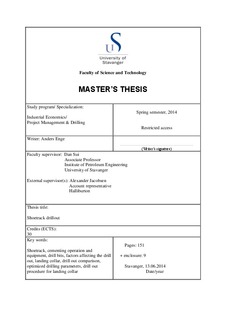| dc.description.abstract | The petroleum industry constantly works to optimize operational aspects within drilling. The cost to drill a well is a parameter all companies want to minimize. To do this new technology and new methods are used to optimize the drilling process. Drilling the shoetrack is a process where components in the bottom of the casing are drilled out. The components include different equipment used when cementing the casing. Drilling the shoetrack can be a time consuming process, generating large cost and problems for the operators. The drilling of the shoetrack includes many factors, making it a complex situation. A study of the drilling parameters will help to optimize this process. Studies of the drilling parameters are expected to reduce the operational cost and time when drilling the shoetrack.
Drilling data from 143 runs were given in order to get a better overview over the problems occurring, and to show were most of the time is used. Special cementing plugs are used to displace the cement slurry and give surface pressure indications during the cementing operation. After the casing is cemented into place, all the equipment in the shoetrack needs to be drilled out in order to reach the next open hole section. The inclination of the wells plotted against the total time to drill the shoetrack, shows that the more deviated a well is, the more time consuming the shoetrack drill out process is. The study further shows that the component in the shoetrack taking the most time to drill is the landing collar, this applies for 6 of 7 casing sizes studied. The landing collar is a component used in the shoetrack when the cementing operation takes place. The cement plugs that displace the cement when pumping will land and seal inside and on top of the landing collar, this will give surface pressure indications, indicating that the cementing job is complete. The use of different bit did not give any big difference when studying all the drilling runs, so for drilling the shoetrack, it is the drilling parameters that account for most of the effect.
The shoetrack drillout of the 10 ¾” liners has shown to take too much time. The focus was therefore directed towards this casing size. A total of 15 wells in this casing size were selected, where Halliburton was the provider of the shoetrack equipment. Further, feet-by-feet data were examined, containing drilling parameters as weight on bit, rotation speed, torque and flowrate. The study included both single stage cemented liners and two stage cemented liners. The study clearly shows that drilling the cementing plug and lading collar, is the process taking most of the time. Since the landing collar took most of the time of the shoetrack drillout, a deeper studied was performed. For the single stage cemented liners a trend was seen when studying the flow rate up against the total time to drill the shoetrack. An increased flow gave better drillout times. For the WOB, no trend was seen. No trends were seen when studying the total drilling time up against WOB and flowrate for the two stage cemented liners. The materials studied for the shoetrack of 10 ¾” liners was relatively soft materials, consisting of aluminium, rubber, plastic and cement.
Connecting the time to drill the landing collar up against the average values of WOB, Torque, flowrate and revolution speed gave some interesting results. The more weight and torque applied the more time the drilling of the landing collar took. The flowrate and rotation speed did not show a large effect in the drill out times. | nb_NO |
